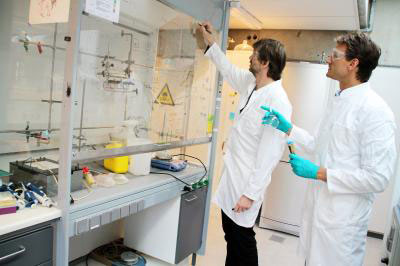| Sep 05, 2013 |
New computational approaches speed up the exploration of the universe
|
|
(Nanowerk News) How many different molecules can be created when you release one of the universe's most reactive substances, hydrogen cyanide, in the lab? And will the process create some particularly interesting molecules?
|
|
That is what scientists call a good question, because hydrogen cyanide seems to have played a role in creating some of life's building blocks. Hydrogen cyanide is an organic compound and it is found in large quantities in the universe. It may have helped in producing amino acids and DNA bases, some of life's basic molecules. If hydrogen cyanide can lead to the formation of amino acids, can it also contribute to the formation of other essential compounds? Can hydrogen cyanide help explain how life originated on Earth? And how it can arise on other planets?
|
|
"It's a great question that scientists worldwide have spent a lot of energy on answering. Hydrogen cyanide can react to a myriad of different molecules. Letting hydrogen cyanide start a reaction in the laboratory corresponds to placing a lot of toys in a large room, let a lot of kids in there and then try to keep up with how the toys are distributed among the children. The number of possible combinations is almost infinite. It has taken a long time to find out which molecules of interest can arise out of hydrogen cyanides reaction", explains associate professor Martin Hanczyc from the Center for Fundamental Living Technology (FLinT), Department of Physics, Chemistry and Pharmacy at the University of Southern Denmark.
|
|
Thursday he will present the work at the European Conference on Artificial Life in Taormina, Italy.
|
 |
| This shows Hanczyc and Merkle by the cabinet where the work with hydrogen cyanide were conducted. Merkle is writing notes on the glass, while Hanczyc holds a sample of reacted hydrogen cyanide.
|
|
Preliminary studies have shown that hydrogen cyanide can contribute to the formation of amino acids. This discovery required month-long experiments in the laboratory, where scientists painstakingly monitored the reactions and continuously manipulated the experiment to keep it on track.
|
|
According to associate professor Daniel Merkle at the Department of Mathematics and Computer Science a novel approach can in a matter of hours or a day spot all the thousands of different molecules that can be formed during the reaction of hydrogen cyanide in the laboratory - even if the experiment has not been manipulated along the way and is allowed to evolve chaotically.
|
|
When Hanczyc and Merkle tested their methods on a hydrogen cyanide reaction in the laboratory they found that many of the molecules that had previously been identified as particularly interesting – for example the DNA base adenine, was automatically discovered.
|
|
"In our study we found that our approaches identified the right molecules. This confirms to us that these novel methods can be used as an effective and reliable tool in chemical analyzes in the future", says Martin Hanczyc.
|
|
One of the first things he would like to explore with the new time-saving technique is the so-called autocatalytic cycles.
|
|
"Chemical reactions can be organized into a self-replicating system, a so-called autocatalytic cycle. Being able to copy itself is one of life's most basic characteristics, so for us who study the origin of life, there is obviously great interest in exploring what it takes for a chemical reaction to copy itself. So far the identification of these cycles has been much more complicated", explains Martin Hanczyc.
|

